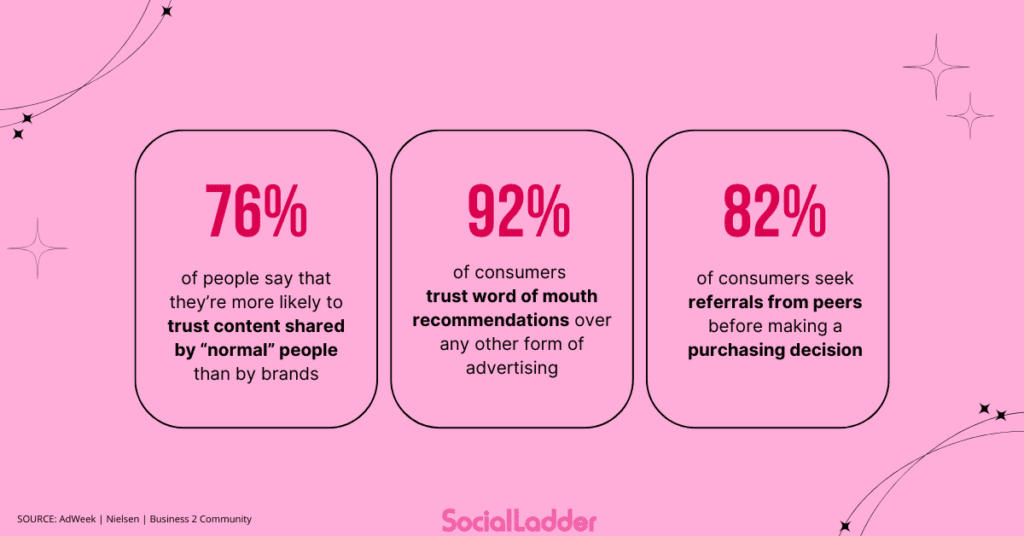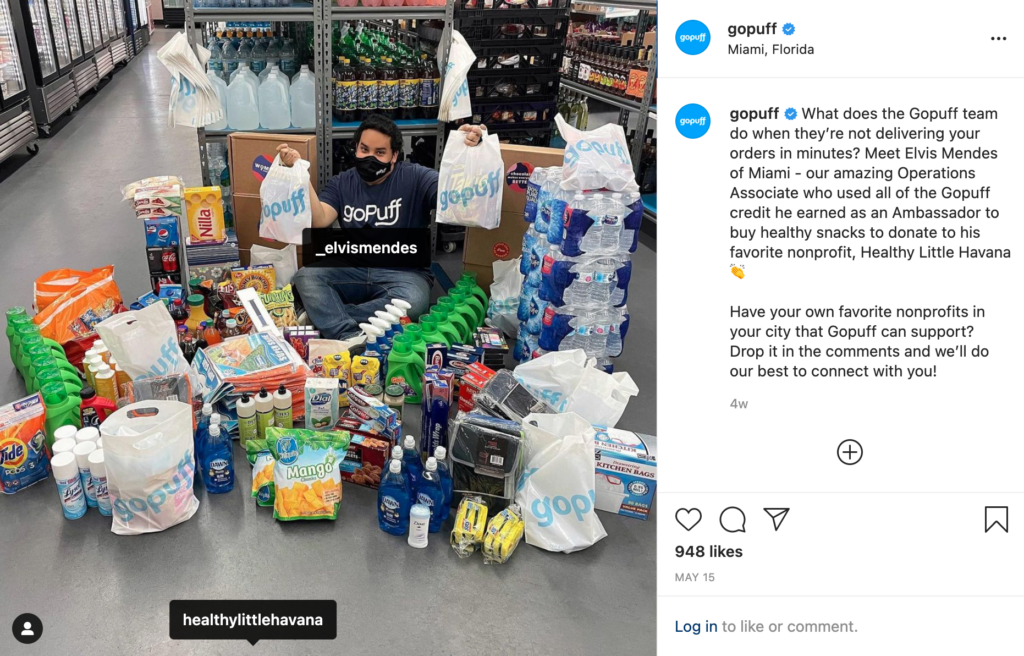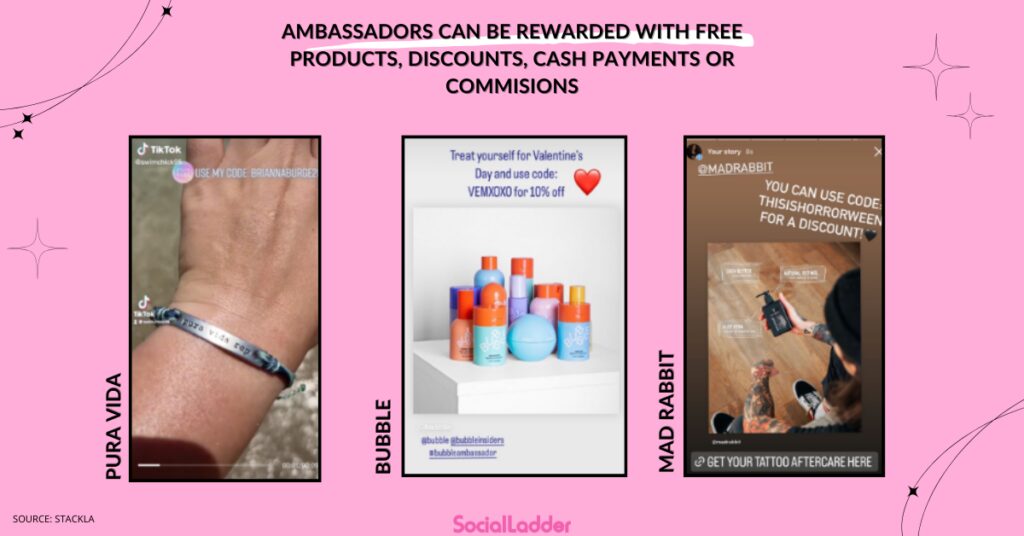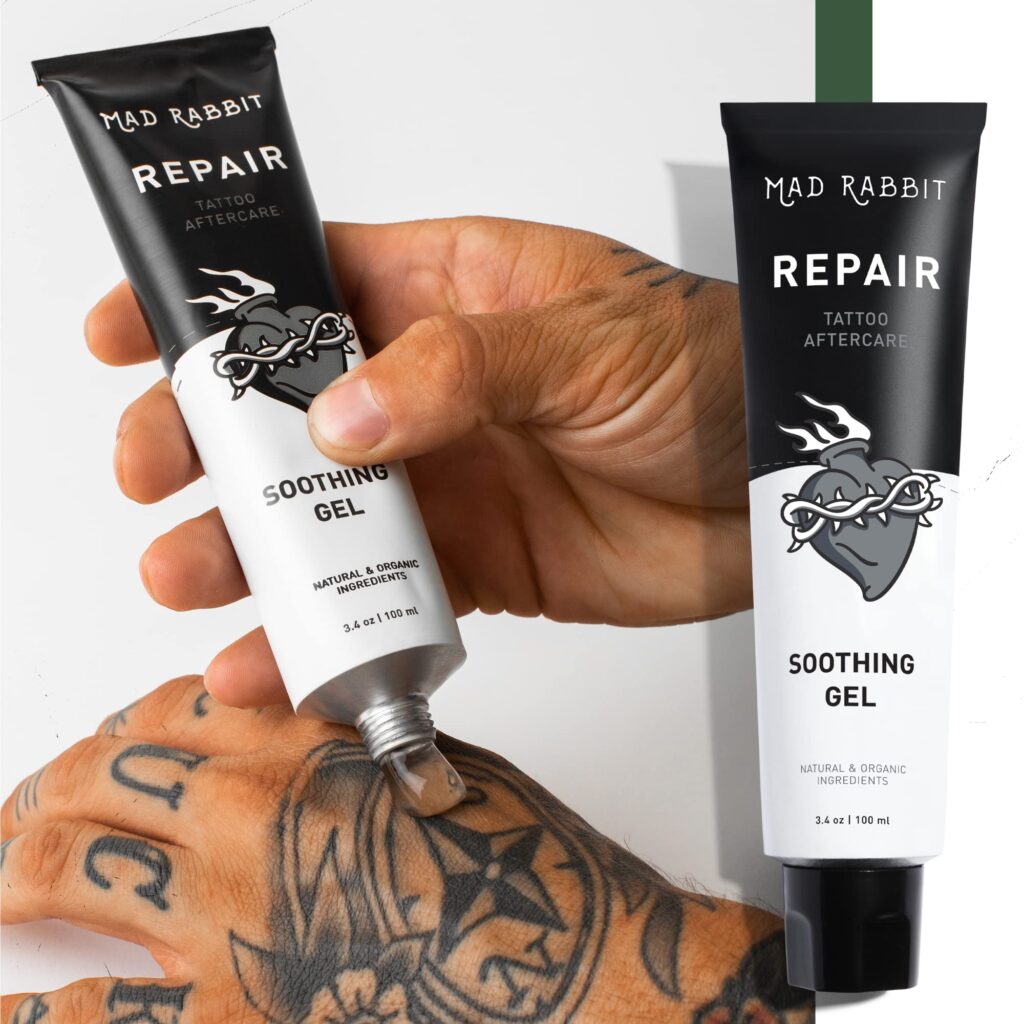You may have heard the terms influencers, affiliates, or brand ambassadors, but what exactly is the difference between these terms?
You may even ask, “What is an influencer, an affiliate, or a brand ambassador?”
+ Read More: Building Advocacy: How to Cultivate a Thriving Ambassador Program
For starters, they are all people with an audience — just like you and me — that forge partnerships with brands for some compensatory reason, be it free products, small commissions, or discounts.
It’s partnering with passionate people to promote your brand.
However, understanding the differences between influencers, affiliates, and brand ambassadors is crucial to determining which will best align with your brand’s goals.
Stay with us as we delve deeper into each role and guide you in making the best choice for your brand!
What is an Influencer?

You may have heard this term all over social media, but what exactly is an influencer, and who would be considered one?
An influencer is someone who can affect people’s decisions based on the audience’s opinions of him or her.
Sound familiar? It should. Affecting decisions lies at the heart of marketing strategy.
But they don’t necessarily need a huge audience to be considered influencers. There are six commonly used categories of influencers based on their follower counts:
- Nano-influencers: 1,000 – 10,000
- Micro-influencers: 10,000 – 50,000
- Mid-tier influencers: 50,000 – 500,000
- Macro-influencers: 500,000 – 1 million
- Mega-influencers: 1 million – 5 million
- Celebrity influencers: Over 5 million followers
Today, small micro-influencers are becoming very popular for brands because they feel more authentic to audiences than big macro influencers, and they are worth considering for your campaigns.
How does Influencer Marketing work?
Typical influencer marketing campaigns generally work this way:
A brand pays (or otherwise compensates in some manner) an influencer to create 1 or 2 pieces of content endorsing a product or service.
After that, the campaign is over. Big ”I” influencer campaigns are very transactional and aren’t designed for long-term, sustainable collaboration. They are always superficial and short-lived partnerships.
However, brands are also realizing that long-term collaborations are more beneficial and more effective. When this happens, the influencers can now be considered brand ambassadors as well.
Nonetheless, it is important to note that macro-influencers are always motivated by money. Meanwhile, collaborations with brand ambassadors are motivated by the creator’s authentic interest in your brand.
Not only does the authenticity make brand ambassadors so effective, but also because brand ambassadors are ordinary people. This brings so much more credibility to both the creator and the brand compared to macro-influencers.

More on these two things below.
Building Advocacy: How to Cultivate a Thriving Ambassador Program
What is an Affiliate?
An affiliate is someone who earns rewards from a brand for bringing in new customers (and sales!) through their own marketing efforts.
These marketing efforts mainly include online activities such as creating social media content (UGC) or writing blog posts. It’s all up to the affiliate to decide what content to create.
How Affiliate Marketing works?
As an affiliate, a person has the flexibility to engage in various activities to promote a brand and generate sales.
At the most basic level, they can simply share their unique affiliate link through social media, email, or their own website. When someone clicks on this link and makes a purchase, the affiliate earns a commission.
Beyond just sharing links, affiliates can also take on the role of a content creator or user-generated content (UGC) producer for the brand.
This involves creating engaging content such as blog posts, videos, or social media posts that highlight the brand’s products or services. By providing valuable insights, reviews, and personal experiences, affiliates can attract and convert more customers, making their marketing efforts more effective and far-reaching.

The main difference between influencer marketing and affiliate marketing is that the latter is performance-based and uses affiliate links.
Successful affiliates have an established audience in their social media platform of preference, which would qualify them as influencers as well. And since you work with affiliates on a long-term basis, they could also qualify as brand ambassadors.
What are Affiliate links?
Affiliate links are unique links given to affiliates that direct to a specific product or service on a website. They allow affiliate management software to track the number of people who clicked on a particular link and how many of those clicks resulted in a sale.
Sometimes these links have a cookie that tracks the clicks and sales for a particular time to give affiliates a better deal.
Affiliates then earn a commission established by the brand for every sale they generate from their marketing efforts and links.
Having an audience isn’t always a requirement to become an affiliate, although it certainly helps. However, without an audience, they won’t successfully earn commissions at any measurable rate.
Make sense?
As you can see, the terms can shift based on the use case and how your program develops over time. Often, we see brands focused exclusively on affiliate marketing pivot and embrace brand ambassadors as part of their overall marketing strategy.
How to Create an Affiliate Program: A Simple Guide
What is a Brand Ambassador?

A brand ambassador – or micro-influencer – is a person who is hired to represent a brand in a positive light and, by doing so, increase brand awareness and sales.
They might not have massive social media followings, but they are authorities in their way. These informal spokespeople keep your brand top-of-mind with their audiences without the overt “buy this” messaging which can dominate traditional influencer programs.
Anyone, including but not limited to customers, employees, influencers, and students without many followers, can be a part of brand ambassador programs.
While affiliates influencers typically engage with brands for monetary compensation and promote products to their large followings, brand ambassadors are passionate advocates who genuinely believe in the brand they represent. Their authentic connections with the product make them invaluable assets in building and nurturing a loyal community.
The Role of Brand Ambassadors in Community Building
The essence of community building lies in creating a sense of belonging among customers, and brand ambassadors excel at this by sharing their authentic love for the product.
When a brand ambassador talks about a product, their enthusiasm is contagious. Audiences are not just hearing a sales pitch; they are witnessing real-life experiences and personal stories that resonate on a deeper level.
This organic attraction helps cultivate a community of like-minded individuals who share a common interest in the brand.
While influencers typically engage with brands for monetary compensation and promote products to their large followings, brand ambassadors are passionate advocates who genuinely believe in the brand they represent. Their authentic connections with the product make them invaluable assets in building and nurturing a loyal community.
This is what makes brand ambassador marketing programs so effective. Brands can hire hundreds of ambassadors (or have open enrollment) that feel authentic to their target demographics, and by extension, tap into new customers.
Brand ambassadors can participate in online activities such as creating social media content, just like affiliates or influencers. However, they can also participate in offline activities, like hosting events, classes, experiential marketing tactics (focal groups), and so on.

How to Start a Brand Ambassador Program: The Best Guide
Influencers, Affiliates, or Ambassadors: What’s the difference?
- Influencers: If someone has an audience of over 1000 followers on any social media platform, they are de-facto influencers. We can drill down even further and categorize these individuals based on follower count and audience reach.
- Affiliates: If you collaborate with influencers/brand ambassadors using affiliate links, they can be called affiliates. Affiliates earn a small commission via trackable links for each sale they drive to your site. Programs often make use of affiliate codes in support of content-focused (UGC) brand ambassadors.
- Brand Ambassadors: Brand ambassadors are individuals who are deeply enthusiastic about a brand and its offerings. Unlike macro-influencers, whose primary motivation is often financial, brand ambassadors are driven by an intrinsic passion for the brand. This authenticity sets brand ambassadors apart and makes them powerful allies in community building. Influencers, in the broadest sense, are conversation starters. They can ignite initial enthusiasm about a product or service, but brand ambassadors continue those conversations. Why? Because your best ambassadors are your current customers, employees, loyalists, fans, and enthusiasts of the brand.
What’s next?
Now that you know exactly what influencers, affiliates, and brand ambassadors are, it’s time to start identifying your goals and planning the ideal influencer marketing program.
As mentioned, they’re all about partnering with people to drive awareness and sales in key demographics. So instead of thinking about definitions, focus on creating a strategy that fits your marketing goals.
So what should you be thinking about?
Based on the current trends for these types of programs:
- Find influencers of any size that actually love your products or services.
- Focus on being authentic, building a community, and building a relationship with your customers.
- Run short-term influencer marketing campaigns to drive awareness when launching a product or service.
- Partner with creators long-term for conversions, building your community, and generating consistent user-generated content.
- Use affiliate links in case you want to pay for performance.
- Consider other compensation methods. Learn more about it here.
Take Mad Rabbit as an example.

Before SocialLadder, Mad Rabbit’s ambassador program was limited by a referral-only approach. Recognizing the potential of a robust brand ambassador program, Mad Rabbit changed its marketing strategy. By fostering a genuine community of brand enthusiasts, they achieved remarkable results.
Since its launch, the tattoo-care company has:
- Increased the size of their ambassador team by 1.7X
- Revenue per month has grown 3X
- The average order increased from 1.7 units to 2 units as a direct impact of ambassadors to sales
- Average order value went up 50%
- A new customer referred to by an ambassador has a higher checkout than a normal checkout value
Mad Rabbit wanted to expand their passionate, dedicated community and elevate their brand to another level. They realized a brand ambassador program through SocialLadder would be the best choice. And ever since working with SocialLadder, they have continued to reach new heights.
Mad Rabbit’s 4,500+ ambassadors Increased the Brand’s Monthly Revenue by 3X
Ready to elevate your brand to the main stage? Click here and contact SocialLadder today to book a demo, and discover how your brand can harness the power of ambassador marketing.



